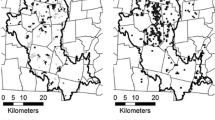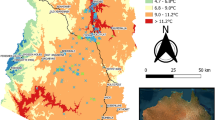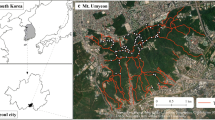Abstract
Since its introduction into North America in the late 19th century, Celastrus orbiculatus (Thumb.) has become a serious ecological threat to native ecosystems. Development of a method to accurately map the occurrence of invasive plants, including C. orbiculatus, would greatly assist in their assessment and control. Using an innovative map regression model, we predicted 85% of presence and absence of C. orbiculatus within our study area. We identify environmental characteristics associated with C. orbiculatus and demonstrate the use of this information to predict occurrence of C. orbiculatus across a broad area in Southern Illinois, USA. Presence and absence information were obtained at sample points within discrete areas of C. orbiculatus occurrence. Forest cover, elevation, slope gradient and aspect, soil pH and texture, distance to nearest road, and potential annual direct incident radiation were recorded for invaded and adjacent non-invaded areas. Presence of oak, elevation, slope gradient, soil pH, soil texture, and distance to road were significant factors associated with the presence or absence of C. orbiculatus. Probability of occurrence of C. orbiculatus was highest on gently sloping interfluves with successional forest canopy not dominated by oak, and less acidic, mesic soil. A logistic regression model was developed and extrapolated over a raster GIS data layer using map algebra to predict current invasion throughout the study area. The model correctly predicted at least 85% occurrence of C. orbiculatus. When combined with logistic regression, map algebra is a potentially powerful tool for evaluating the spatial distribution of invasive plants provided sound statistical principles are applied in extrapolating validated regression models.





Similar content being viewed by others
References
Baird JW (1980) The selection and use of fruit by birds in an eastern forest. Wilson Bull 92:63–73
Byers JE, Reichard S, Randall JM, Parker IM, Smith CS, Londsale WM, Atkinson IAE, Seastedt TR, Williamson M, Chornesky E, Hayes D (2002) Directing research to reduce the impacts of non-indigenous species. Conserv Biol 16:630–640
Conservation New England (1998) The introduction of non-native plants to New England. http://site.www.umb.edu/conne/. Cited 10 Jan 2006
Davis MB (1987) Invasion of forest communities. In: Grey A, Crawley M, Edwards J (eds) Colonization, succession and stability. Blackwell, Oxford, pp 373–393
Davis MA, Grime JP, Thompson K (2000) Fluctuating resources in plant communities: a general theory of invasibility. J Ecol 88:528–534
Dreyer G (1988) Efficacy of triclopyr in root killing oriental bittersweet and certain other woody weeds. In: Proceedings of the Northeastern Weed Science Society 42: 120–121
Dreyer G (1994) Elemental stewardship abstract for Celastrus orbiculatus. The Nature Conservancy, Arlington, Virginia
Dreyer G, Braid LM, Fickler C (1987) Celastrus scandens and Celastrus orbiculatus: comparison of reproductive potential between a native and an introduced woody vine. Bull Torrey Bot Club 114:260–264
Ellsworth JW, Harrington RA, Fownes JH (2004) Survival, growth and gas exchange of Celastrus orbiculatus seedlings in sun and shade. Am Midl Nat 151:233–240
Environmental Systems Research Institute, Inc (2005) ArcView 9.0
Garcia-Robledo CA, Murcia C (2005) Comparative habitat susceptibility to invasion by Chinese ash (Fraxinus chinensis: Oleaceae) in a typical Andean landscape. Biol Invasions 7:405–415
Greenberg CH, Smith LM, Levey DJ (2001) Fruit fate, seed germination and growth of an invasive vine—an experimental test of the ‘sit and wait’ strategy. Biol Invasions 3:363–372
Heine RA, Lant CL, Sengupta RR (2004) Development and comparison of approaches for automated mapping of stream channel networks. Ann Assoc Am Geogr 94:447–490
Herman RJ, Miles CC, Dungan LA, Currie BE, Ice PW (1979) Soil survey of Jackson County, Illinois. United States Department of Agriculture, Washington, DC
Hierro JL, Maron JL, Callaway RM (2005) A biogeographic approach to plant invasions: the importance of study of exotics in their introduced and native range. J Ecol 93:5–15
Hobbs RJ (1989) The nature and effects of disturbance relative to invasion. In: Drake J, Mooney H, Dicastri F, Groves R, Kruger F, Rejmanek M, Williamsson M (eds) Biological invasions: a global perspective, Scope. Wiley, New York, 37:389–405
Hobbs RJ, Huenneke LF (1992) Disturbance, diversity, and invasion: implications for conservation. Conserv Biol 6:324–337
Hoppes WG (1988) Seedfall patterns of bird-dispersed plants in an Illinois woodland. Ecology 69(2):320–329
Index of Exotic Species (2004) Illinois Department of Natural Resources. http://dnr.state.il.us/lands/eduction/ExoticSpecies. Cited Jan 10 2006
Invasive Plant Atlas of New England (2005) http://invasives.uconn.edu/ipane. Cited Jan 10 2006
Knight KS, Reich PB (2005) Opposite relationships between invisibility and native species richness at patch versus landscape scales. Oikos 109:81–88
List of Invasive Species (1990) Illinois Natural History Survey. http://www.inhs.uiuc.edu/chf/outreach/VMG/rlbitter.html. Cited Jan 10 2006
List of Invasive Species (1999) Virginia Department of Conservation. http://www.dcr.state.va.us/dnh/invlist.htm. Cited Jan 10 2006
Lloret F, Médail F, Brundu G, Camarda I, Moragues E, Rita J, Lambdon P, Hulme PE (2005) Species attributes and invasion success by alien plants on Mediterranean islands. J Ecol 93:512–521
McCune B, Keon D (2002) Equations for potential annual direct incident radiation and heat load. J Veg Sci 13:603–606
McNab W, Meeker M (1987) Oriental bittersweet: a growing threat to hardwood silviculture in the Appalachians. Northern J Appl For 4:174-177
National Oceanic and Atmospheric Administration (2004) National Climate Data Center, National Environment, Satellite, Data, and Information Service. http://www.nesdis.noaa.gov. Cited April 15 2005
Native Plant Society of New Jersey (2005) Invasive Species of New Jersey. http://www.npsnj.org/invsive_species_0203.htm
Non-native Vegetation of Missouri (2002) Missouri Botanical Garden. http://www.mobot.org/MOBOT/research/mepp/alphalist.shtml. Cited Jan 10 2006
Orians GH (1986) Site characteristics favoring invasions. In: Mooney H, Drake J (eds) Ecology of biological invasions of North America. Springer-Verlag, New York, pp 113–148
Patterson DT (1974) The ecology of oriental bittersweet, Celastrus orbiculatus, a weedy introduced ornamental vine. Ph.D. Dissertation, Duke University
Pimentel D, Lach L, Zuniga R, Morrison D (2000) Environmental and economic costs of nonindigenous species in the United States. Bioscience 50:53–65
Pinter N, Vestal W (2005) El Nino-driven landsliding and postgrazing vegetative recovery, Santa Cruz Island, California. J Geophys Res 110, F2, doi.10.1029/2004JF000203
Plant Conservation Alliance, Alien Plant Working Group (1997). Oriental bittersweet (Celastrus orbiculatus Thunb.). Bureau of Land Management, Washington, DC
Plant Database. United Stated Department of Agriculture, Natural Resources Conservation Service. 2005. http://plants.usda.gov. Cited Jan 10 2006
Planty-Tabachhi AE, Tabachhi E, Nieman RJ, DeFerrari C, Decamps H (1996) Invasibility of species rich communities in riparian zones. Conserv Biol 10:598–607
Rand TA, Russell FL, Louda SM (2004) Local- vs. landscape-scale indirect effects of an invasive weed on native plants. Weed Technol 18(Suppl S):1250–1254
Rawlings JO (1988). Applied regression analysis: a research tool, Wadsworth Inc., USA, 553 p
Rejmanek M, Richardson DM (1996) What attributes make some plant species more invasive? Ecology 77:1655–1660
Rhode Island Invasive Plants (2005) Rhode Island Wild Plant Society. http://www.riwps.org/PlantLibrary/invasives/descriptions/oriental_bittersweet.htm. Cited Jan 10 2006
Rudis VA (2005) New findings of the forestland survey of nonnative plant invasions in the south. In: Proc. Southeast Exotic Pest Plant Council 7th Annual Conf. Birmingham, AL. http://www.se-eppc.org/2005/Rudis_7th_SE_EPPC.pdf
Saura S, Carballal P (2004) Discrimination of native and exotic forest patterns through shape irregularity indices: an analysis in the landscapes of Gallica, Spain. Landsc Ecol 19:647–662
Silveri A, Dunwiddie P, Michaels H (2001) Logging and edaphic factors in the invasion of an Asian woody vine in a mesic North American forest. Biol Invasions 3:379–389
SPSS 2004. Version 13.0. SPSS Inc., Chicago
Stohlgren TJ, Otsuki Y, Villa CA, Lee M, Belnap J (2001) Patterns of plant invasions: a case example in native species hotspots and rare habitats. Biol Invasions 3:37–50
Strickler GS (1959) Use of the densiometer to estimate density of forest canopy on permanent sample plots. USDA-FS, Pacific Northwest Forest and Range Experiment Station Research Note. 180:1–5
Tennessee and Southeast Exotic Pest Plant Council (2004) Invasive Plants of Tennessee. http://www.tneppc.org/TNEPPC2004/PlantList_8x11.pdf. Cited Jan 10 2006
Thomas JR, Middleton BA, Gibson DJ (2006) A landscape perspective of the stream corridor invasion and habitat characteristics of an exotic (Dioscorea oppositifolia) in a pristine watershed in Illinois. Biol Invasions 8:1103–1111
Tibbetts T (2000) The ecology of the exotic, invasive temperate liana Celastrus orbiculatus (Oriental bittersweet) Ph.D. Dissertation, University of Michigan
Tomlin C (1990) Geographic information systems and cartographic modeling. Prentice Hall, NJ
Tutorial on Invasive Species (2005) Pennsylvania Department of Conservation and Natural Resources. http://www.dncr.state.pa.us/forestry/invasivetutorial/List.htm. Cited Jan 10 2006
Voigt JW, Mohlenbrock RH (1964) Plant communities of southern Illinois. Southern Illinois University Press, Carbondale, Illinois, USA
Wisconsin Flora (2005) Wisconsin Botanical Information System. http://www.botany.wisc.edu/wisflora. Cited Jan 10 2006
Wrigley N (1985) Categorical data analysis for geographers and environmental scientists. Longman Inc., New York
Acknowledgements
We acknowledge the staff of Giant City Park, in particular Jenny Skufca, for their cooperation and assistance in site location and description, as well as land use history within the park. We are grateful to Bob Lindsey, Illinois Department of Natural Resources, for the assistance of his interns, Dan Cox and Kari Foster.
Author information
Authors and Affiliations
Corresponding author
Rights and permissions
About this article
Cite this article
Pande, A., Williams, C.L., Lant, C.L. et al. Using map algebra to determine the mesoscale distribution of invasive plants: the case of Celastrus orbiculatus in Southern Illinois, USA. Biol Invasions 9, 419–431 (2007). https://doi.org/10.1007/s10530-006-9049-x
Received:
Accepted:
Published:
Issue Date:
DOI: https://doi.org/10.1007/s10530-006-9049-x




